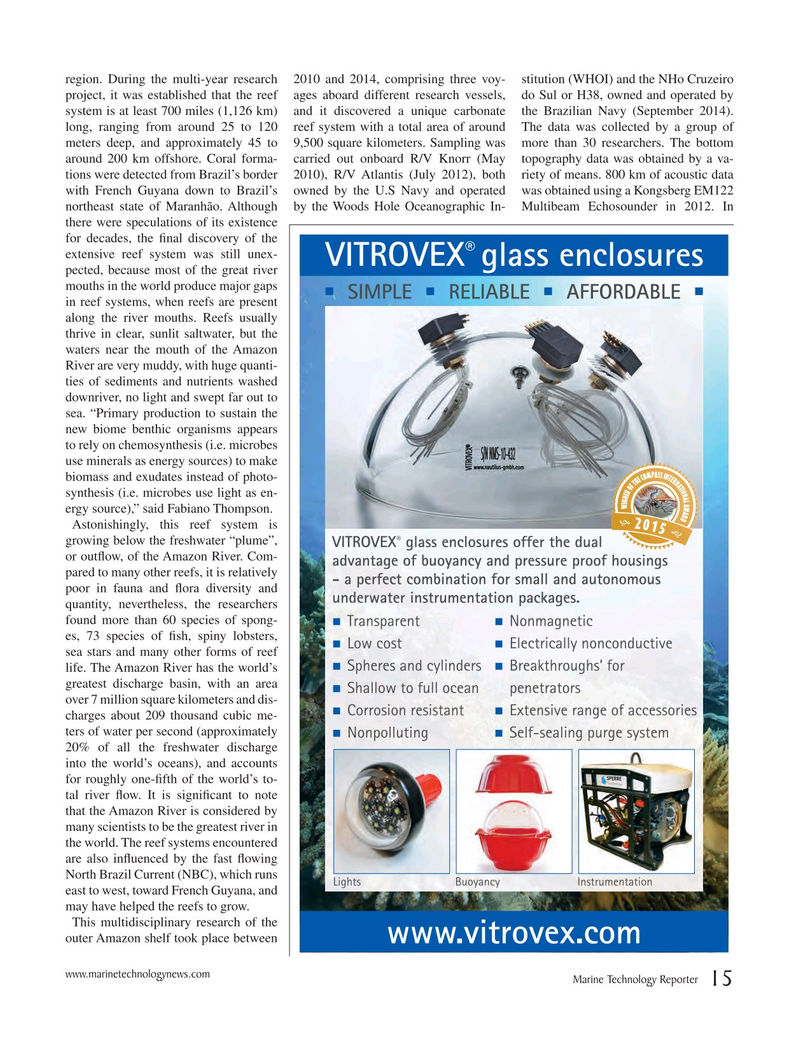
Page 15: of Marine Technology Magazine (September 2016)
Ocean Observation: Gliders, Buoys & Sub-Surface Networks
Read this page in Pdf, Flash or Html5 edition of September 2016 Marine Technology Magazine
region. During the multi-year research 2010 and 2014, comprising three voy- stitution (WHOI) and the NHo Cruzeiro project, it was established that the reef ages aboard different research vessels, do Sul or H38, owned and operated by system is at least 700 miles (1,126 km) and it discovered a unique carbonate the Brazilian Navy (September 2014). long, ranging from around 25 to 120 reef system with a total area of around The data was collected by a group of meters deep, and approximately 45 to 9,500 square kilometers. Sampling was more than 30 researchers. The bottom around 200 km offshore. Coral forma- carried out onboard R/V Knorr (May topography data was obtained by a va- tions were detected from Brazil’s border 2010), R/V Atlantis (July 2012), both riety of means. 800 km of acoustic data with French Guyana down to Brazil’s owned by the U.S Navy and operated was obtained using a Kongsberg EM122 northeast state of Maranhão. Although by the Woods Hole Oceanographic In- Multibeam Echosounder in 2012. In there were speculations of its existence for decades, the ? nal discovery of the extensive reef system was still unex- pected, because most of the great river mouths in the world produce major gaps in reef systems, when reefs are present along the river mouths. Reefs usually thrive in clear, sunlit saltwater, but the waters near the mouth of the Amazon
River are very muddy, with huge quanti- ties of sediments and nutrients washed downriver, no light and swept far out to sea. “Primary production to sustain the new biome benthic organisms appears to rely on chemosynthesis (i.e. microbes use minerals as energy sources) to make biomass and exudates instead of photo- synthesis (i.e. microbes use light as en- ergy source),” said Fabiano Thompson.
Astonishingly, this reef system is growing below the freshwater “plume”, or out? ow, of the Amazon River. Com- pared to many other reefs, it is relatively poor in fauna and ? ora diversity and quantity, nevertheless, the researchers found more than 60 species of spong- es, 73 species of ? sh, spiny lobsters, sea stars and many other forms of reef life. The Amazon River has the world’s greatest discharge basin, with an area over 7 million square kilometers and dis- charges about 209 thousand cubic me- ters of water per second (approximately 20% of all the freshwater discharge into the world’s oceans), and accounts for roughly one-? fth of the world’s to- tal river ? ow. It is signi? cant to note that the Amazon River is considered by many scientists to be the greatest river in the world. The reef systems encountered are also in? uenced by the fast ? owing
North Brazil Current (NBC), which runs east to west, toward French Guyana, and may have helped the reefs to grow.
This multidisciplinary research of the outer Amazon shelf took place between www.marinetechnologynews.com
Marine Technology Reporter 15
MTR #7 (1-17).indd 15 8/24/2016 5:10:06 PM

 14
14

 16
16
